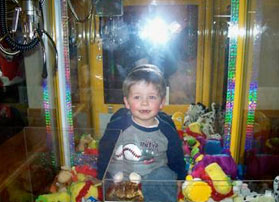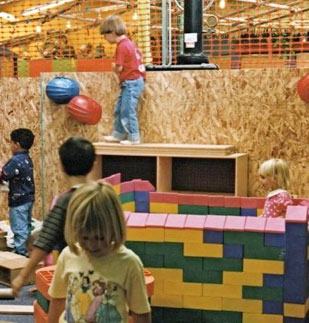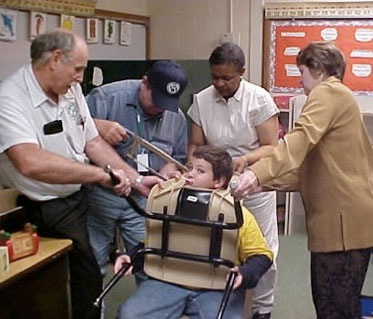
Vol. IX, No. 3, Sept-Dec 2010
The Challenge of Designing Environments for Children
A version of this article was previously published at Blooloop.com
 Children will do the strangest and most unpredicted things when it comes to interacting with the environment. Just when you think you have figured things out, a child can find a new way to interact with the environment. A few years ago, a seven-year-old boy crawled inside an arcade-type crane machine at a supermarket in Sheboygan, Wisconsin, and then couldn’t get out. When firefighters arrived, the child was sitting inside the machine among the stuffed animals. He had crawled into the machine through the 8-inch by 10-inch toy discharge chute while his father talked on the phone a few feet away. The child remained calm during the hour that it took a locksmith to free him, then headed straight for the toilet.
Children will do the strangest and most unpredicted things when it comes to interacting with the environment. Just when you think you have figured things out, a child can find a new way to interact with the environment. A few years ago, a seven-year-old boy crawled inside an arcade-type crane machine at a supermarket in Sheboygan, Wisconsin, and then couldn’t get out. When firefighters arrived, the child was sitting inside the machine among the stuffed animals. He had crawled into the machine through the 8-inch by 10-inch toy discharge chute while his father talked on the phone a few feet away. The child remained calm during the hour that it took a locksmith to free him, then headed straight for the toilet.
As this incident illustrates, children will make things in the environment that aren’t meant to be interactive, interactive, and often in ways that are quite surprising. The younger the child, the more likely this will occur. Children view environments completely differently than adults. Adults view the environment in terms of its intended function and as background. So if something like a bench is in a public place, adults will interpret it only for its socially acceptable use, as a seat. Children on the other hand are biologically wired as part of their development to explore and interact with the environment. So children will interpret and evaluate the bench for all the ways they can interact with it. They search for the environment’s affordances -- the opportunities it affords them to do things with it. In the case of the bench, they see its opportunities for climbing on, running across, jumping over and hiding behind or under.
A long straight hall in a building is another illustration of how the environment tells children to behave. A child sees it as affording her a chance to run. Similarly, a wall one-half meter high is perfect for walking and balancing on. In all these situations, the child is not misbehaving. She is doing exactly what her brain is biologically programmed by evolution to have her do. She is fulfilling what is known as her development tasks, one of which is to explore and interact with the world. When a child behaves in an environment in a way that adults see as improper, it is usually not the child's fault. They are really not misbehaving. More often the resultant behavior is the designer’s fault for not appropriately designing the environment for children.
 One of the many challenges of designing environments for use by children to offer them the correct affordances for the desired behaviors and avoid affordances that cause children to use the environment in inappropriate ways. This is accomplished by offering children age-appropriate affordances. Children need to be challenged so they won’t become bored. Otherwise, they will start interacting with other elements in inappropriate ways or sometimes become aggressive in their behavior. Of course, there is also the issue of eliminating affordances for the wrong behavior, such as not having walls that can be climbed and walked on, or long straight halls.
One of the many challenges of designing environments for use by children to offer them the correct affordances for the desired behaviors and avoid affordances that cause children to use the environment in inappropriate ways. This is accomplished by offering children age-appropriate affordances. Children need to be challenged so they won’t become bored. Otherwise, they will start interacting with other elements in inappropriate ways or sometimes become aggressive in their behavior. Of course, there is also the issue of eliminating affordances for the wrong behavior, such as not having walls that can be climbed and walked on, or long straight halls.
Children’s developmental tasks and skill levels change continually in predictable ways as they age and develop. Children's physical (fine and gross motor), intellectual and social skills are constantly improving, so to be engaging for all the children using the environment, it must offer what is known as graduated challenges, a range of challenges. Even children of the same age have different skill levels.
Young children’s highest quality play harnesses their incredible imaginations. The environment needs to be designed to support their imaginative role-play and be open-ended so children can develop their own play scripts. Highly scripted, structured and overly themed environments stifle children’s creativity, hinder extended play and can quickly lead to boredom.
And then there are anthropometrics and ergonomics, (sometimes referred to as human factors engineering) which mean designing things to match children's physical sizes and abilities. This includes such characteristics as height, grip, reach, field of vision, etc. It doesn’t do any good to design an environment or equipment that doesn't fit a child's anthropometrics and skill levels and isn’t ergonomically correct. Either he will not be able to use the equipment or he will feel incompetent trying to, and neither outcome will make him competent. Poorly designed equipment, furniture and environments that don't match children’s anthropometrics can actually be dangerous. If a shelf is too high and a child wants something on it, she will often find a way to get to it -- likely in an unsafe manner such as climbing on lower shelves that may not be designed to support the weight of a child.
As complicated as all this sounds, good design gets even more challenging.
Children's attention spans can be much shorter than adult’s. Something that interests a child 10-minutes later can become boring. To overcome this challenge, the environment must offer a wide variety of options. A lack in the variety of equipment and materials limits children's play options and leads to increased levels of boredom and aggression. Another factor that drives the need for variety is the multiple intelligences. The theory of multiple intelligences, first developed by Howard Gardner, says we all possess eight distinct and somewhat autonomous intelligences to differing degrees — linguistic, logical-mathematical, musical, spatial, bodily kinesthetic, intrapersonal, interpersonal and naturalist. We tend to be most interested in activities that match our stronger intelligences. There are also distinct differences between the interests of girls and boys. Therefore, the variety of activities must appeal to the broadest range of multiple intelligences and to both genders, just as a restaurant needs a varied menu to appeal to a variety of customers’ food preferences.
The scale of the environmental space also influences children’s behavior. The more child-scaled the space, the higher the quality and complexity of children’s play will be, and the longer they will be preoccupied in the play. In other words, a child-scaled environment increases children's interest and concentration, and it delays boredom. A large open space becomes over stimulating; children are encouraged by the environment’s design to constantly move their attention from one thing to another. In small, contained areas, they will be more focused. Areas for different activities need to be well defined with identifiable boundaries that children can interpret. The relationship between areas and activities, what we call adjacencies and zoning, also has an impact on children's behavior and the quality of their activities.
Other factors also influence children's behavior and enjoyment of play and entertainment. Indoors this includes the décor, colors, lighting and acoustics. Outdoors, nature and the abundant use of greeneries in informal arrangements have been shown to enhance children’s concentration, reduce their stress, increase their feelings of well-being and encourage them to use their imaginations.
Predictability and routine are especially important to younger children. It helps give them a sense of control over the environment and their daily lives. If an environment a child repeatedly visits is constantly changing, the child will experience discomfort and anxiety.
 Environments need to be designed so they can be deciphered by children, so they can orient themselves, recognize how the space they are in connects to adjoining spaces and figure out how to get to a desired destination -- a concept know as wayfinding. Children’s short stature makes this especially challenging unless the environment is designed from a child’s-eye view. Younger children don't read. So where signs work for adults, the environment itself needs to be designed to give children equivalent non-language wayfinding communication.
Environments need to be designed so they can be deciphered by children, so they can orient themselves, recognize how the space they are in connects to adjoining spaces and figure out how to get to a desired destination -- a concept know as wayfinding. Children’s short stature makes this especially challenging unless the environment is designed from a child’s-eye view. Younger children don't read. So where signs work for adults, the environment itself needs to be designed to give children equivalent non-language wayfinding communication.
Safety is also a crucial consideration. The environment must be designed not only to prevent unsafe behavior and injury, but also designed to minimize injury when an incident occurs. Situations where a child cannot evaluate the risk, such as head and finger entrapments, need to be avoided. To be interesting to children, play equipment must present some risks, but risks where a child can evaluate the challenge. What are considered risks for older children can be hazards for younger children, so environments often require age segregation into different areas. Environments with activities that are safe when children are supervised can be dangerous if children are left unsupervised.
Children’s familiarity with each other also affects their play and interactions with other children. A group of children who are regularly together in a kindergarten or school class will interact differently both with the environment and with each other than will children who are strangers. The same environment won't necessarily work for both groups.
Another consideration is that children are more sensitive to environmental hazards than adults are. This includes chemicals, mold and VOC emissions (volatile off-gassing organic chemicals from building materials). Good air quality is essential. Children are shorter and often play on the floor, so standard HVAC performance specifications don’t always address their comfort. Toxicity and sanitation are especially important considerations for parents of very young children who will often mouth anything they come into contact with.
Accessibility for children with disabilities is another design challenge. Unfortunately, government accessibility codes fail to adequately address children's accessibility, as they focus mainly on wheelchair accessibility for adults and fail to address the challenges faced by children with non-wheelchair mobility disabilities, including walkers, leg braces, limited vision, Attention Deficit Disorder (ADD) and Attention Deficient Hyperactivity Disorder (ADHD). The other problem is that following accessibility code standards can often make the environment and equipment unusable by able-bodied children. An approach known as universal design is required to make environments truly usable by the greatest number of children. Universal design is an approach that addresses the right for everyone — from children to the elderly and of all abilities — to use all environments, products and information in an independent, inclusive, and equal way.
Durability and maintenance are important considerations in designing any environment that children will occupy. Children will give things more wear and tear than adults do and will definitely get things dirtier faster. Materials need to be durable and easy to clean and maintain. Using materials and finishes that can be sanitized is important, especially when infants and toddlers will be present in the environment being designed.
Designing for children is no simple task. If you put children in an environment not properly designed for them, all kinds of unexpected and undesired behaviors and outcomes result. It’s the responsibility of adults to design children's environments carefully to produce the desired behaviors and make them safe and adult-friendly too. Positive outcomes for children will be produced only when the environments have been designed with a thorough knowledge of child development, anthropometrics, ergonomics, environmental factors, wayfinding, environmental psychology and universal design.

